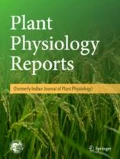Abstract
Bentazone {3-isopropyl-1H-2,1,3-benzothiadiazin-4(3H)-one-2,2-dioxide} categorized under thiadiazine group is a selective herbicide that is widely used for weed control in cereals, onions, garlic and other related crops. Field and laboratory experiments were conducted for 5 weeks to assess some of the responses of Allium cepa (a non-target plant) to herbicide treatment. Growth, physiological, cytotoxic and genotoxic parameters were determined. The result showed that bentazone significantly decreased plant growth and protein content; while level of malondialdehyde increased by 56.25 %. Chromosomal aberration and DNA damage were also associated with bentazone treatment on A. cepa. It was concluded that bentazone herbicide could cause genotoxicity and physiological disorders in non-targeted plants.



References
Ashton, F. M., & Crafts, A. S. (1973). Mode of action of herbicides. New York: Wiley.
Badr, A., Ghareeb, A., & El-Din, H. M. (1992). Cytotoxicity of some pesticides in mitotic cells of V. faba roots. Egyptian Journal of Applied Sciences, 7, 457–468.
Bradshaw, L., Barret, M., & Poneleit, C. (1992). Physiological basis for differential bentazone susceptibility among corn (Zea mays L.) inbreds. Weed Science, 40, 522–527.
Burton, J. D., & Maness, E. P. (1992). Constitutive and inducible bentazone hydroxylation in Shatter cane (Sorghum bicolor) and Johnson grass (Sorghum halapense). Pesticide Biochemistry and Physiology, 44, 40–49.
Devine, M. D., & Preston, C. (2000). The molecular basis of herbicide resistance. In A. H. Cobb & R. C. Kirkwood (Eds.), Herbicides and their mechanisms of action (pp. 72–104). Sheffield: CRC Press.
Eastin, E. F. (1978). Total nitrogen determination for plant material containing nitrate. Analytical Biochemistry, 85, 91–594.
Evseeva, T. I., Geras’kin, S. A., Shuktomova, I. I., & Taskaev, A. I. (2005). Genotoxicity and cytotoxicity assay of water sampled from the underground nuclear explosion site in the north of the Perm region (Russia). Journal of Environmental Radioactivity, 80, 59–74.
Fleming, A. A., Banks, P. A., & Legg, J. G. (1988). Differential response of maize inbreds to bentazone and other herbicides. Canadian Journal of Plant Science, 68, 501–507.
Fusconi, A., Repetto, O., Bona, E., Massa, N., Gallo, C., Dumas-Gaudot, E., & Berta, G. (2006). Effect of cadmium on meristem activity and nucleus ploidy in roots of Pisum sativum L. cv. Frisson seedlings. Environmental and Experimental Botany, 58, 253–260.
Gronwald, J. W., & Connelly, J. A. (1991). Effect of monooxygenase inhibitors on bentazone uptake and metabolism in maize cell suspension cultures. Pesticide Biochemistry and Physiology, 40, 284–294.
Hess, F. D. (2000). Light-dependent herbicides: An overview. Weed Science, 48, 160–170.
Liman, R., Akyil, D., Eren, Y., & Konuk, M. (2010). Testing of the mutagenicity and genotoxicity of metolcarb by using both Ames/Salmonella and Allium test. Chemosphere, 80, 1056–1061.
Michelle-Frainer, K., Antonio, C. F., Thais, S., & Solange, B. T. (2006). Effects of Pterocaulon polystachyum DC. (Asteraceae) on Onion (Allium cepa) root-tip cells. Genetics and Molecular Biology, 29, 539–542.
Nemat Alla, M. M., Badawi, A. M., Hassan, N. M., El-Bastawisy, Z. M., & Badran, E. G. (2008). Effect of metribuzin, butachlor and chlorimuron-ethyl on amino acid and protein formatin in wheat and maize seedlings. Pesticide Biochemistry and Physiology, 90, 8–18.
Osama, A., & Floyd, M. A. (1984). Bentazone influence on selected metabolic processes of isolated bean leaf cells. Journal of Plant Growth Regulation, 3, 121–126.
Ozakca, D. U., & Silah, H. (2013). Genotoxicity effects of Flusilazole on the somatic cells of Allium cepa. Pesticide Biochemistry and Physiology, 107, 38–43.
Pateiro-Moure, M., Arias-Estévez, M., López-Periago, E., Martínez-Carballo, E., & Simal-Gándara, J. (2008). Occurrence and downslope mobilization of quaternary herbicide residues in vineyard-devoted soils. Bulletin of Environmental Contamination and Toxicology, 80, 407–411.
Qian, H., Hu, H., Mao, Y., Ma, J., Zhang, A., Liu, W., & Fu, Z. (2009). Enantioselective phytotoxicity of the herbicide imazethapyr in rice. Chemosphere, 76, 885–892.
Ramalho, J. C., Pons, T. L., Groeneveld, H. W., Azinheira, H. G., & Nunes, M. A. (2000). Photosynthetic acclimation to high light conditions in mature leaves of Coffea arabica L.: Role of xanthophylls quenching mechanisms and nitrogen nutrition. Australian Journal of Plant Physiology, 27, 43–51.
Rutherford, A. W., & Krieger-Liszkay, A. (2001). Herbicide-induced oxidative stress in photosystem II. Trends in Biochemical Science, 26, 648–653.
Saxena, P. N., Gupta, S. K., & Murthy, R. C. (2010). Carbofuran induced cytogenetic effects in root meristem cells of Allium cepa and Allium sativum: A spectroscopic approach for chromosome damage. Pesticide Biochemistry and Physiology, 96, 93–100.
Sharma, K. K., Lavanya, M., Sharma, V., Lavanya, M., & Anjaiah, V. (2000). A method for isolation and purification of peanut genomic DNA suitable for analytical applications. Plant Molecular Biology Reporter, 18, 393a–393h.
Sharma, S., & Vig, A. P. (2012). Genotoxicity of Atrazine, Avenoxan, Diuron and Quizalofop-P-ethyl herbicides using the Allium cepa root chromosomal aberration assay. Terrestrial and Aquatic Environmental Toxicology, 6, 90–95.
Shigenaga, M. K., & Ames, B. N. (1991). Assays for 8-Hydroxy-2′-deoxyguanosine: A biomarker of in vivo oxidative DNA damage. Free Radical Biology and Medicine, 10, 211–216.
Sterling, T. M., & Balke, N. E. (1989). Differential bentazone metabolism and retention of bentazone metabolites by plant cell cultures. Pesticides Biochemistry and Physiology, 34, 39–48.
Ukaegbu, M. C., & Odeigah, P. G. C. (2009). Genotoxic effects of sewage effluent on Allium cepa. Rep Opin, 1, 36–41.
Wang, H., & Jin, J. Y. (2005). Photosynthetic rate, chlorophyll fluorescence parameters, and lipid peroxidation of maize leaves as affected by zinc deficiency. Photosynthetica, 43, 591–596.
Wang, Y., Lu, X., Sun, M., Song, F., Li, L., Gao, T., & Yan, J. (2008). Physiological research on the difference of bentazone tolerance in wild type rice and sensitive lethal mutants. Acta Agronomica Sinica, 34, 1615–1622.
Wu, C., & Wang, C. (2003). Physiological study on bentazone tolerance in inbred corn (Zea mays). Weed Technology, 17, 565–570.
Author information
Authors and Affiliations
Corresponding author
Rights and permissions
About this article
Cite this article
Odjegba, V.J., Adeniran, R.A. Bentazone herbicide induces genotoxic effect and physiological disorders in non-targeted Allium cepa L.. Ind J Plant Physiol. 20, 375–379 (2015). https://doi.org/10.1007/s40502-015-0168-1
Received:
Accepted:
Published:
Issue Date:
DOI: https://doi.org/10.1007/s40502-015-0168-1

